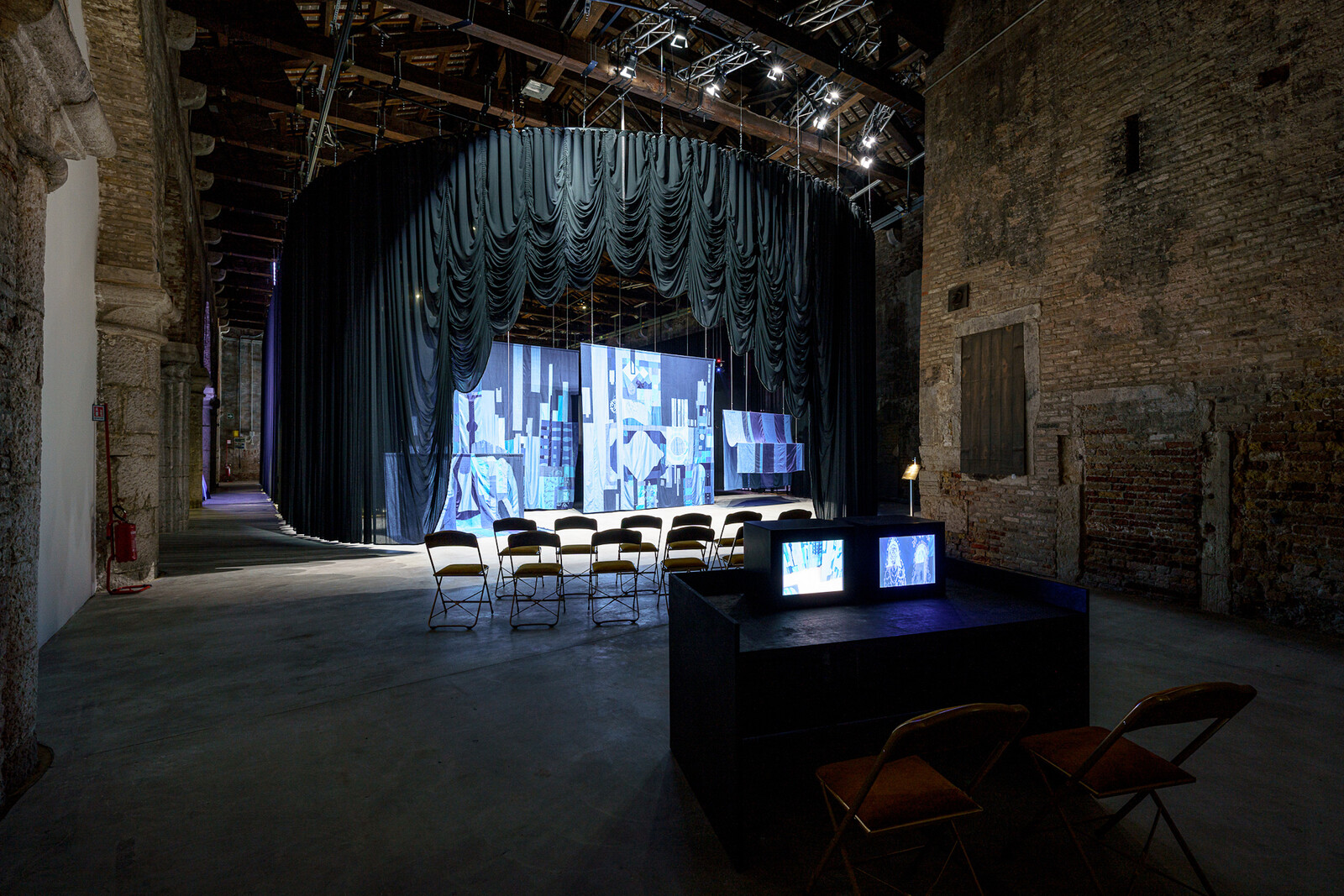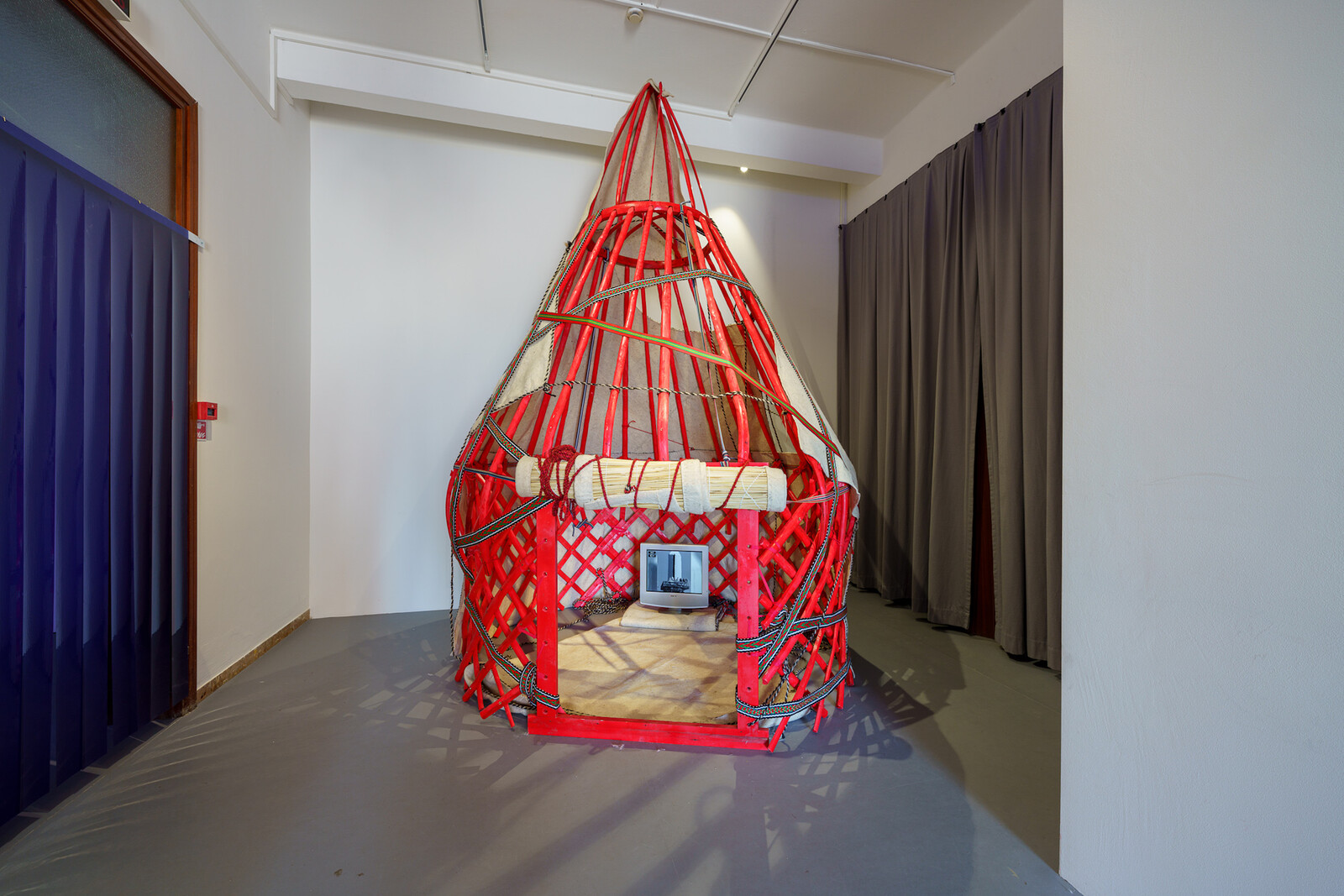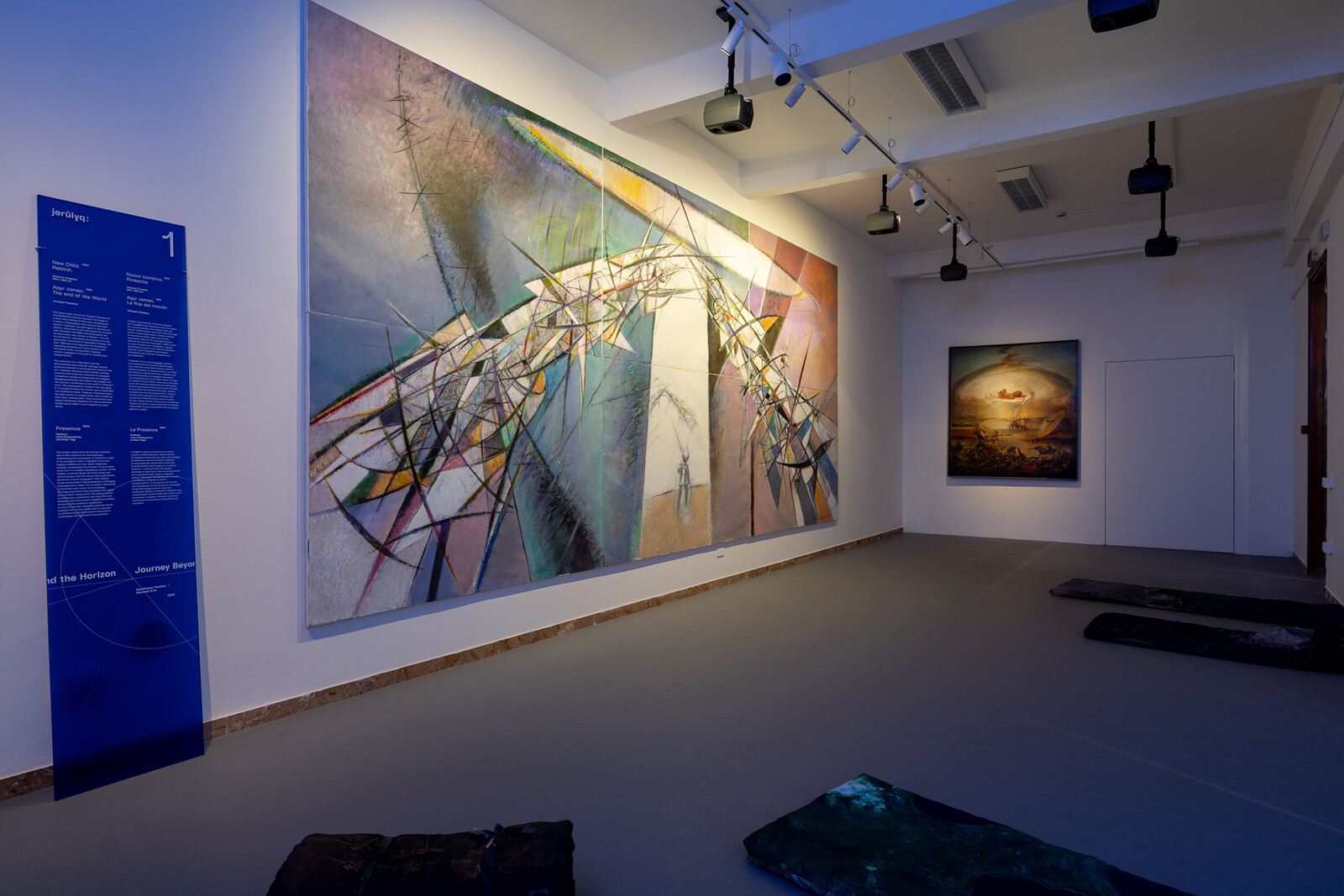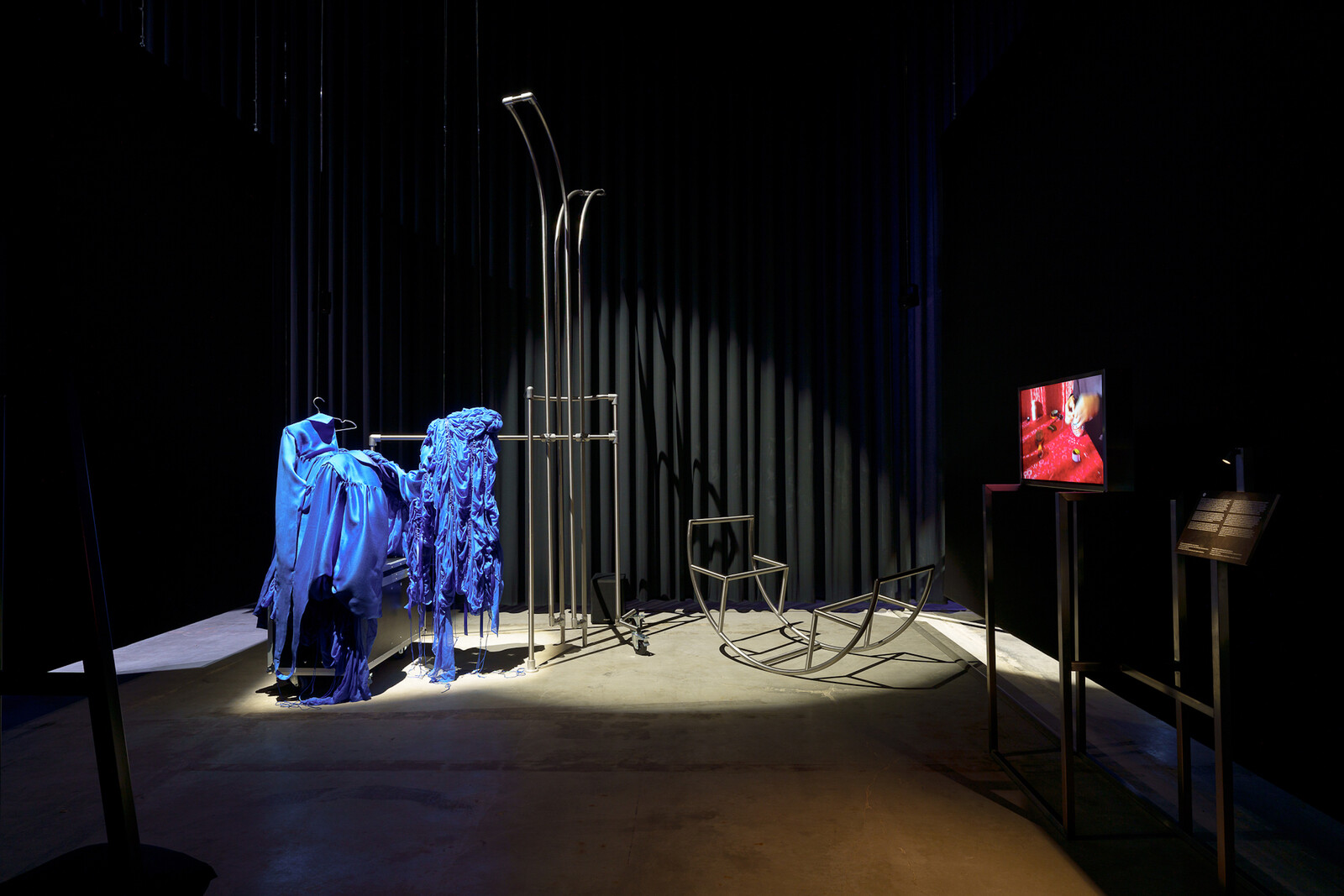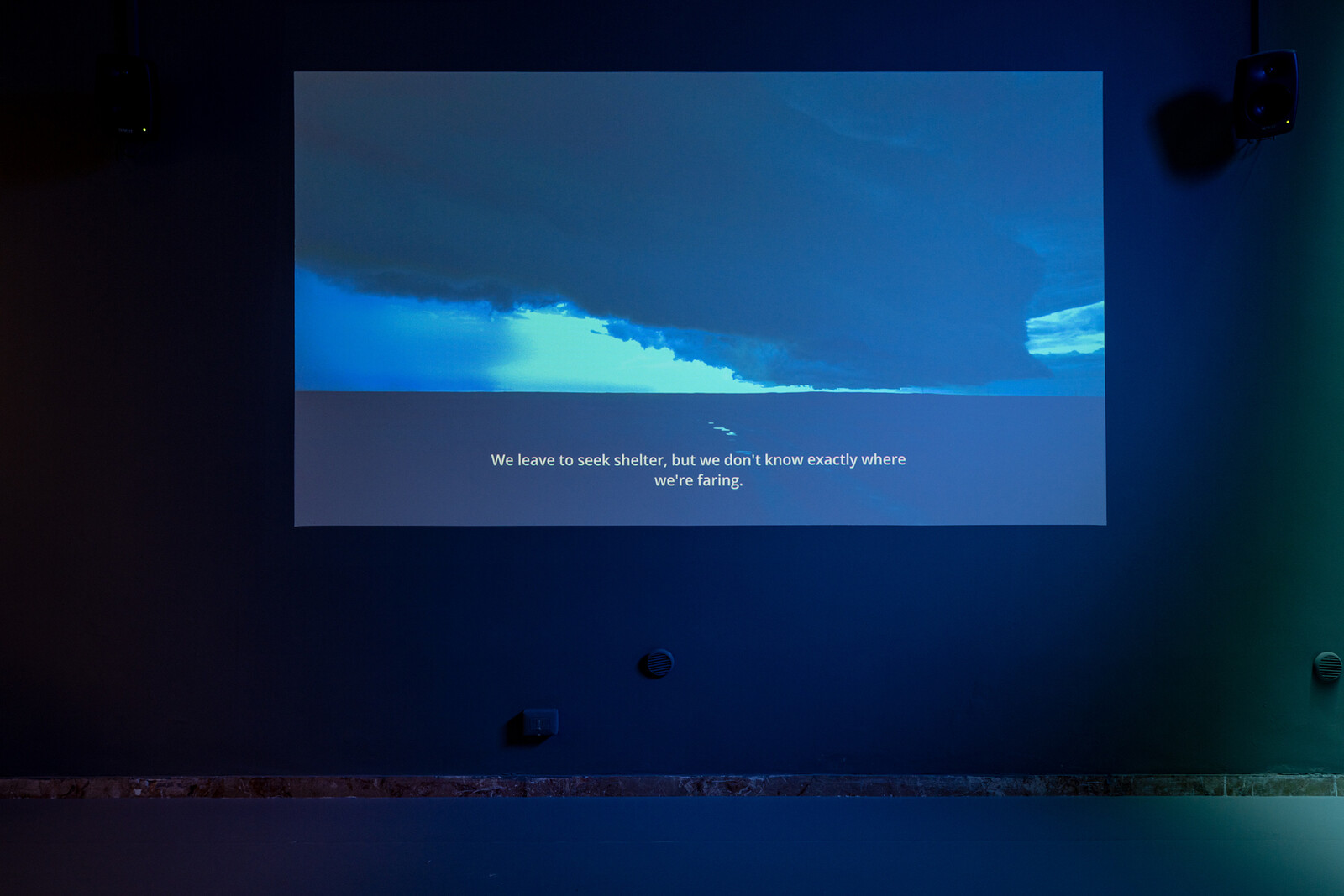Between 2005 and 2013, the Central Asian Pavilion at the Venice Biennale presented work from the region.1 For the past two editions, Uzbekistan and Kazakhstan have exhibited independently, which raises the question of what they hope to achieve. The Uzbekistan Pavilion is run by the state-funded Art and Culture Development Foundation, which is closely connected to President Shavkat Mirziyoyev through his daughter and official advisor Saida, who is known as the country’s image-maker.2 It has significant resources to “integrate the art of Uzbekistan into the global art and cultural space,” including by staging spectacular installations in a spacious pavilion at the heart of the Arsenale.3
Compared to these soft power aspirations, the Kazakhstan Pavilion is a private initiative, if also closely linked to family networks, in this case between curator and artist. For the 2024 edition of the Biennale, Astana gallerist Danagul Tolepbay wanted to exhibit the works of her father, Yerbolat Tolepbay, one of the most famous “official” artists of his generation, in a parallel program. Being receptive to the idea, representatives of the Biennale communicated to her that no official submission for the national pavilion had yet been made. So she sought and received approval and some support from the Ministry of Culture of Kazakhstan, complemented by private sponsors. Expanding the exhibition beyond a solo show, Danagul invited former Tselinny Center of Contemporary Art employee Anvar Musrepov to join as a co-curator. Both strategies have its strong and weak points: While Kazakhstan’s participation in the Biennale might end if the state does not take a greater stake in future projects, the top-down approach of Uzbekistan instrumentalizes art as an expression of national policy.
What is notable, despite the differences, is that art from Central Asia is forced to foreground its own postcoloniality, decoloniality, or indigeneity as a condition of entering a global art world which is preoccupied by identity. (Here I must acknowledge my own position, as someone grateful to the Kazakh and Uzbek—particularly the Tashkent—art communities for their invaluable support during my emigration from Russia in 2022-2023.) The Uzbekistan Pavilion presents a “speculative theater” of postcolonial multiculturalism.4 Artist Aziza Kadyri collaborated with the grassroots feminist collective Qizlar (the word means “girls” in Uzbek) to produce “Don’t Miss the Cue,” which centers on women’s personal memories of migration. Sculptural objects—composed of suzani, patchworked textiles, and modified storage racks supplemented by screens and sounds—are presented in a darkened space. Rather than direct social commentary, the title suggests a stage in which imaginative and generalized migrant women from Uzbekistan, along with the visitors following them, perform “a quest for visibility,” a desire that Kadyri also “craved as a younger migrant woman.”5
The Kazakhstan Pavilion, meanwhile, constructs something like a decolonial futurism. It takes the first part of its title “Jerūiyq: Journey Beyond the Horizon” from the mythical country of abundance described in ancient Kazakh legends, interpreted by the curators as a “Kazakh Wakanda.”6 Six artists and collectives— Sergey Maslov, Saken Narynov, Yerbolat Tolepbay, the2vvo (Lena Pozdnyakova and Eldar Tagi), Kamil Mulashev, and Anvar Musrepov—are paired across three small rooms. The exhibition combines paintings, sculptural objects, installation, sound, and video-essay, produced between 1979 and 2024. Conceptually the show oscillates between the dialectic poles of utopia and dystopia, neo-traditionalism and modernism, mythological and secular, cosmic space and land (in this case, the steppe), presence and absence. However, the works of art tend to collapse these binaries: as, for example, in the image of a “cosmic nomad” in Maslov’s installation, or the idea of post-apocalyptic shamanism as an advanced cosmotechnic in Musrepov’s video. If one of art’s functions today is the production of transcendence, then this post-secular transcendence often works through the geographical imagination, giving form to that immanence in the retrieval of such mythical lands as Jerūiyq, the legend of which has been passed down for centuries via the oral tradition.7
There is a complex dialectic at play in these exhibitions. First, decolonial indigeneity weakens the hegemony of the Global North, but at the same time, through the selective inclusion of other identities, this hegemony becomes “thin” and more invisible, allowing it to persist. Moreover, even some radical critical theories on the subject are based on the unexamined reproduction of “Indigeneity” as the savage Other.8 So artists and countries labeled “postcolonial” must adopt one of two strategies. Either try to move within systems applied from the outside, or attempt to exceed them: either “don’t miss the cue” or “journey beyond the horizon.”
The globalized field of contemporary art—at least as figured at this edition of the Biennale—presents artists and curators from the Global South with two strategies regarding identity. Either to “navigate” the field, using classic postcolonial tools such as hybridity and transitivity to find one’s own way in a system premised upon multiculturalism and fluidity; or to break through to an “authentic” identity, which is constantly displaced and accessible only as the trace of multiple erasures. These two approaches are apparent in the two pavilions’ color schemes: both use blue as the key, but signifying the largely secularized tradition, performed in a smooth digital space of the blue screen for Uzbekistan and suggesting spirituality and twilight on the steppe in the case of Kazakhstan.
These differences correlate to the respective historical experiences of the two countries. Uzbekistan, as a crossroads of trade and a meeting point of cultures, served in the twentieth century as a diplomatic hub for communication between the so-called “Third World” and the USSR. The Kazakhstan steppes, meanwhile, became the site for numerous military bases and testing grounds. Uzbekistan has learned to benefit from hybridity, migration, and diplomacy. Its geographical imaginary is the Silk Road, while Kazakhstan’s is something more like a steppe heterotopia. The Kazakh steppes also played a significant role in the Soviet space program, which might contribute to the cosmic imaginary associated with the country’s contemporary artists.9 The political regimes of both countries are authoritarian. But if the Kazakh regime takes pains to look democratic and modest along the lines of a social and “listening” state, the Uzbek regime is more reminiscent of the Gulf states, with a conspicuously and unashamedly wealthy elite.
This is the field of opportunities within which the art of Central Asia must operate today. And, to a certain extent, the same might be said of all art from the Global South. The choice is between either postcolonial hybrid “civility” or decolonial indigeneity. The trademark multi-vectorism of Central Asia might, through its art and the reception of its art, help us to understand the ongoing global post-neoliberal transition to multipolarity.10
The countries to participate over the period are Kazakhstan, Kyrgyzstan, Tajikistan, and Uzbekistan. For more details see Georgy Mamedov, “Sites of Construction and Political Dissent: Central Asia Pavilions in Venice 2005–2013,” Asia Art Archive (April 1, 2015), https://aaa.org.hk/en/like-a-fever/like-a-fever/sites-of-construction-and-political-dissent-central-asia-pavilions-in-venice-20052013.
In the exhibition booklet for “Don’t Miss the Cue” Saida Mirziyoyeva is listed as “Special support: Saida Mirziyoyeva, Advisor to the President of the Republic of Uzbekistan.” Between November 2020 and August 2023, she served as the head of the Communications and Information Policy Sector of the Executive Office of the President. See “Starshai͡a Dochʹ Shavkata Mirziëeva Naznachena Imidzhmeĭkerom Uzbekistanan,” Fergana.ru, 12 April 2019, https://fergana.ru/news/106585/. Regarding her position at ACDF see “Uzbekistan Unveils Extensive Cultural Programme at EXPO2020 Dubai,” https://old.acdf.uz/en/news/ekspo-2020-dubay-uzbekistan-v-oae-predstavlyaet-obshirnuyu-kulturnuyu-programmu.
See the official ACDF website: https://acdf.uz/en.
Uzbek Pavilion “Don’t Miss the Cue” booklet reads “Visitors find themselves backstage in a speculative theater.” 5
Ibid. 8.
“ВЕНЕЦИАНСКАЯ БИЕННАЛЕ 2024: ПАВИЛЬОН РК | кураторы о тематике, об искусстве и участии государства,” (“Baur Jean Sagiyev. Interview with curators,”) TAJ (April 17, 2024), https://www.youtube.com/watch?v=kgKidxIEzOw.
Celso Sánchez-Capdequi and Josetxo Beriain, “Creativity, Transcendence, and Social Constellations,” Current Sociology vol. 72, no. 2 (March 2024): 235–52.
Jodi A. Byrd, The Transit of Empire: Indigenous Critiques of Colonialism (Minneapolis: University of Minnesota Press, 2011), xx–xxi.
Christine Bichsel, Ekaterina Filep, and Julia Obertreis, “The Soviet Steppe: Transformations and Imaginaries—Introduction,” Slavic Review vol. 81, no. 1 (Spring 2022): 1–7.
See for example Alexander Cooley, “Central Asia as Global,” in Central Asia: Contexts for Understanding, ed. David W. Montgomery (Pittsburgh, PA: University of Pittsburgh Press, 2022), 3–19.
